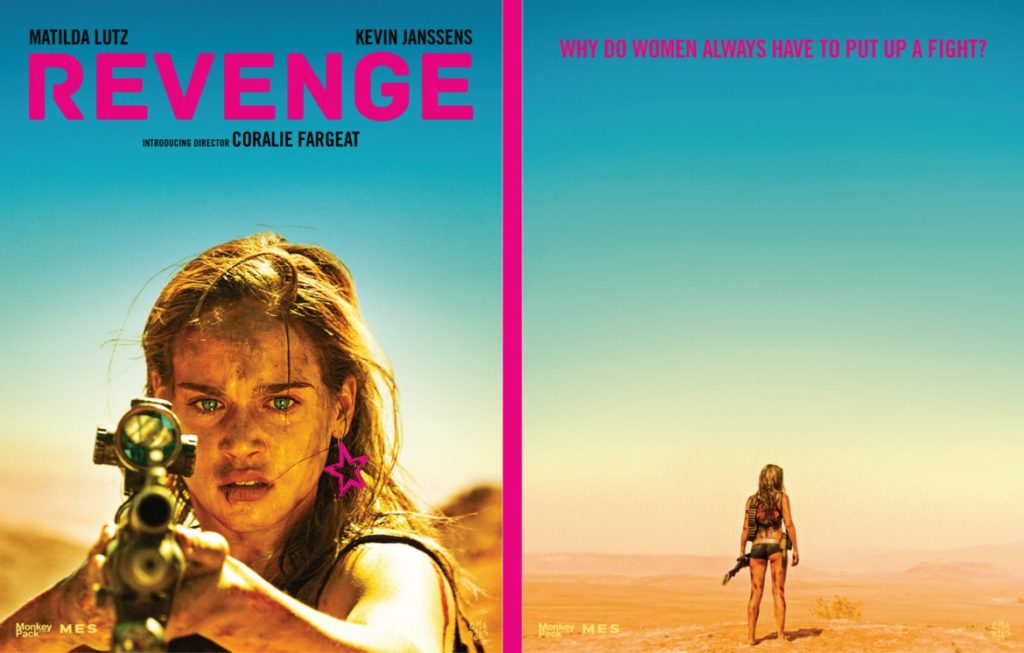Art can be a coping mechanism through which we process our most difficult traumas. Through rape-revenge cinema (and therapy), I was able to finally confront my own painful experiences and stop blaming myself. Though many feminist critics deride the subgenre as misogynistic by default, rape-revenge movies can be a great form of catharsis. Each film should stand on its own merit and be examined individually, because this is a surprisingly varied genre.
Within rape-revenge cinema there are two broad types of films: those in which the victim of rape is the one getting the revenge, and those in which she dies/cannot get revenge, and someone does it for her. The latter, depicted in films like DEATH WISH (1974), IRREVERSIBLE (2002), and I SAW THE DEVIL (2010) are fascinating in their own right but the complete removal of female agency removes any catharsis. Sure, we see the bad guy getting their comeuppance, but the victim herself never gets the satisfaction of delivering said vengeance.
What makes female-driven revenge cinema so powerful is that it allows women who have been wronged to be angry and vengeful. I have no way of getting revenge on the men who have hurt me. Even if I wanted to, I know how revenge stories end. Watching women regain their autonomy and violently destroying those who harmed them onscreen is the closest thing I’ll get to closure. Watching Camille Keaton castrate a man in a bathtub in I SPIT ON YOUR GRAVE (1978) felt like the first salve to my years-old wounds. Thinking of myself as part of a sisterhood that included Beatrix Kiddo, Prisoner Scorpion, and Lisbeth Salander made me feel less like a victim and more like a survivor. This restructuring of what a rape victim was in my own mind was crucial.

Do these women look like victims to you?
The difficulty with rape-revenge movies lies in the exploitation of female pain for entertainment. In order to set up the antagonists as evil, the act of rape itself is often depicted onscreen. Watching even mild rape scenes can be triggering to those who have experienced trauma, but many of these films depict rape to graphic extremes. I SPIT ON YOUR GRAVE has three brutal rape scenes, each more degrading than the last. Movies with male directors tend to focus on the rape act for longer, either to titillate or horrify.
Compare the 9-minute single-camera rape sequence in Gaspar Noe’s IRREVERSIBLE to the rape scenes in female-helmed revenge flicks. The Soska Sisters’ AMERICAN MARY (2012) shows us Mary’s rape at the hands of her professor, but it’s not sexualized in any way. Mary’s assault is gut-churning, her attacker lamely thrusting atop her as she lies back, drugged and scared. In Coralie Fargeat’s REVENGE (2018), the lead-up to protagonist Jen (Matilda Lutz)’s assault is brutally uncomfortable, but the audience never sees the actual assault. We hear it in her pained screams, but even those are soon drowned out by a car race on the television. It’s just more noise.

The poster for ‘Revenge’, highlighting its slyly feminist take.
By removing the exploitative, lengthy rape scenes from the revenge films, viewers who may have experienced their own trauma are better able to enjoy them. What’s more, instead of capitalizing on brutality for brutality’s sake, both AMERICAN MARY and REVENGE focus on the protagonist’s suffering and rise, which makes them more like traditional, male-based revenge flicks. The gender politics at play and differences in sexual power are reduced when the audience doesn’t ever view the attacker as powerful. Mary’s professor is a pathetic middle-aged man who humps like a turtle. The assailant in REVENGE is awkward and fumbling. They are never the laughing imps of I SPIT ON YOUR GRAVE or LAST HOUSE ON THE LEFT, they are not the demonic figures of Gaspar Noe’s works. Instead, they’re utterly, disgustingly human.
Removing the mythology around sex and rape is integral to understanding our feelings about it. Instead of portraying rapists as comic book-esque villains, female storytellers tend to portray them as deeply flawed human beings. They are not redeemable, but they’re not invincible, either. The victims then, become the mythical creatures of the story. They are the phoenixes risen from the ashes, the survivors who can withstand hell and then deliver it themselves. It hasn’t been that long since women who had sex before wedlock were considered tarnished goods, and raped women were included in that.
These cinematic women basically look right in the camera and say, “fuck that”.

Mary (Katharine Isabelle) doesn’t have time for your puritan, patriarchal crap.
These are women reclaiming their worth and standing up for themselves. In a world where each new day reveals another woman silenced because of a man’s untoward sexual advances, it’s refreshing to see women fight back. Before Harvey Weinstein opened the floodgates and millions of women rose to say #MeToo and #TimesUp, rape revenge flicks were some of the only models of strength and resilience we had.
Some feminist critics deride even female-helmed rape-revenge cinema as being too focused on the male gaze. Both AMERICAN MARY and REVENGE have come under fire for their depictions of Mary and Jen as sexual beings. This puritanical desire to remove all sexuality from our avenging heroines makes them into sexless, nigh-virginal martyrs. Showing Jen’s six-pack abs under her sick new stomach brand or Mary’s thighs under fishnets isn’t about the viewer ogling Jen or Mary, it’s about each of these women being comfortable in their own skin in the wake of their abuse. Women can be powerful and sexy without it being an affront to feminism.
Rape-revenge cinema isn’t for everyone. Some viewers will find reliving their experiences through fiction too painful, others simply won’t want to experience this level of darkness. For those looking to explore both the horror and inspiration of a survivor’s story, rape-revenge movies can be eye-opening and cathartic. By empowering more women to tell these stories behind the camera, we can amplify authentic depictions of trauma and rebirth. Through these stories, women like me might find their own strength.
—DANIELLE RYAN
Tags: American Mary, last house on the left, rape revenge, Revenge


Great read, and thank you for sharing your perspective. They are difficult movies to watch, but I totally agree that these films are less exploitative with a female in the driver’s seat. (I don’t think I could ever watch I Spit On Your Grave ever again.)